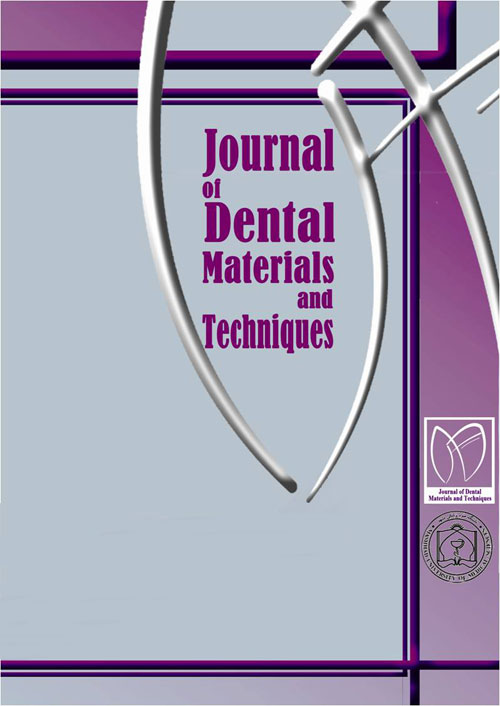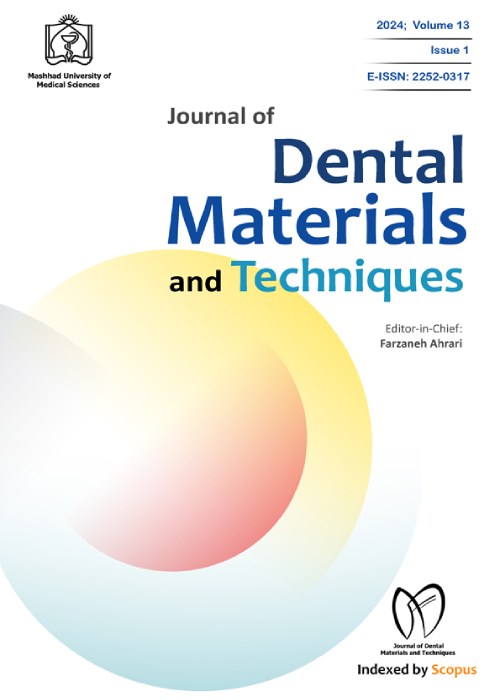فهرست مطالب

Journal of Dental Materials and Techniques
Volume:5 Issue: 3, Summer 2016
- تاریخ انتشار: 1395/04/19
- تعداد عناوین: 10
-
-
Pages 112-113
-
Pages 114-119IntroductionFailures might occur at metal‒porcelain interfaces as a problem with metal‒ceramic restorations even with the application of airborne-particle abrasion technique. This study was undertaken to evaluate the effect of Nd:YAG laser treatment on the bond strength of porcelain fused to metal.MethodsTwenty-four cylindrical specimens (4 mm in diameter and 4 mm in height) were made of a commercially available nickel‒chromium alloy by lost-wax technique. Half of the specimens were surface-treated by air-borne particles and the other half was irradiated with Nd:YAG laser beams (wavelength of 1064 nm, energy and frequency of 120 mJ and 10 Hz, respectively, and a power setting of 6 kW). All the specimens (air-abraded and laser-treated) were covered with a 4-mm layer of opaque porcelain in two-stage baking and subjected to shear bond strength test (a 10-kgf at 1 mm/min) until fracture occurred. A fractured specimen from each group was evaluated using scanning electron microscopy. T-test was used for statistical analysis and statistical significance was set at PResultsShear bond strength was higher in the sandblasted group compared to the laser-etched group (PConclusionIt can be concluded that Nd:YAG laser irradiation increases the shear bond strength of Ni-Cr alloy to porcelain, but further studies should be carried out to evaluate the effect of different parameters of Nd:YAG laser treatment on shear bond strength.Keywords: Crowns, dental prosthesis, lasers, dental porcelain, nickel, chromium, beryllium alloy, aluminum oxide
-
Pages 120-124Aim: The purpose of this study was to compare the difference in the output intensity of Light Emitting Diode (LED) light cure (LC) devices with and without a protective sleeve and its clinical significance.Materials And MethodsThe output intensity of 152 LC units in dental offices across the state of Odisha were examined. The collection of related information included an average number of exposures per day and the charging status. LED Radiometer (SDI Ltd, VIC, AUS) was used for measuring output intensity.ResultsOut of all the 152 LC devices examined, 137 were found to emit light intensity above minimum baseline values when used with a protective sleeve. The decrease in output intensity, when used with a protective sleeve was statistically significant (pConclusionLED Light cure devices can be safely used along with a protective sleeve to improve cross infection control without affecting its output intensity. Battery operated LED devices must be charged at least 3 times/ week to prevent a significant decrease in output intensityKeywords: composite, Infection control, Protective sleeve, Output intensity of LED light cure
-
Pages 125-130Growing demand of invisible braces byesthetically conscious patients has led to remarkable inventions in materials for esthetic labial archwires. Archwires with excellent optical clarity and mechanical properties comparable to conventional archwires have been manufactured by almost all the leading companies of orthodontic products in the past two decades, but their clinical use is still limited. Esthetic archwires can be divided into two main types, which are transparent non-metallic archwires (composite wires) and metallic wires with esthetic coatings. This article intends to provide an overview of various types of esthetic archwires available, and to gather evidence from the literature regarding their clinical applicability.Keywords: Esthetic, Tooth colored, composite, coated archwire
-
Pages 131-137BackgroundDuring root canal treatment procedures, unexpected accidents may be confronted affecting long-term prognosis just as in any other dental treatment. The purpose of this study was to evaluate the knowledge of dental students of accidents and errors during endodontic treatment in Medical University of Babol.Materials And MethodsIn this cross-sectional study, 52 senior dental students were examined. Required information was collected with a questionnaire with 20 questions relating causes, prevention, treatment and prognosis of accidents during endodontic treatment. Data was analyzed using descriptive parameters, chi-square test and T-test by the statistical software SPSS Ver.21.ResultsThe student's knowledge was moderate in all of the fields studied including causes, prevention, treatment and prognosis of accident during endodontic treatment. Their knowledge of the causes of accidents during endodontic treatment was the lowest level and their awareness of the required endodontic treatment was the highest. There were no significant differences (P>0.05) in the average knowledge of students in the four areas of causes, prognosis, prevention and treatment of accidents of endodontic treatment. There was a significant difference in the average knowledge of the causes between male and female dental students (PConclusionThe findings of this study suggest that the level of awareness of dental students of events during endodontic treatment in Babol University of Medical Sciences is moderateKeywords: accident during endodontic treatment, awareness, dental students
-
Pages 138-144IntroductionDifferent oral lesions have clinical characteristics which in some cases are similar. Therefore, in these cases histopathological examination for correct diagnosis is necessary. The aim of this study was to evaluate the compatibility rate of clinical and histopathological diagnosis of oral lesions in Zahedan School of dentistry.MethodsIn this retrospective study, determination of the compatibility of clinical and histopathological diagnosis was done using 631 available records in department of pathology, Zahedan School of dentistry, during 1999- 2015. Type of the lesions (neoplastic and non-neoplastic), and demographic data including age, gender, location of lesions (intraosseous or soft tissue), and clinicians specialty was extracted from patients records and data were analyzed using SPSS (V.21) software and Chi- Square test.ResultsTotal compatibility rate between clinical and histopathological diagnosis was 70.1%. The most accurate clinical diagnosis was related to lichenoid lesions (100%) and leukoplakia (100%) and verrucous carcinoma had the least diagnostic compatibility (20%). There was no significant relationship between compatibility of histopathological and clinical diagnosis with age range, gender, location, and clinicians specialty. Also non-neoplastic lesions with compatible histopathological and clinical diagnoses were three times more than neoplastic lesions. (P=0.03).ConclusionAlthough there was a great compatibility between clinical and histopathological diagnosis, many records had no clinical diagnosis and the inconsistency was also significant. Therefore, more attention to clinical signs and effective cooperation between the clinician and pathologist for correct and more accurate diagnosis and treatment is recommended.Keywords: Clinical Diagnosis, Histopathologic Diagnosis, Oral Manifestations
-
Pages 145-152ObjectivesThe aim of this study was to evaluate the effect of six herbal teas on the color stability of two types of nanohybrid and one microhybrid resin composite.Materials And Methods70 disc-shaped specimens, 210 in total (7*2mm), were fabricated from each of the following materials in metal mould : Tetric N ceram, Grandio, Gradia Direct Anterior. Specimens were stored in distilled water at 37°C for 24 hours in an incubator for completion of polymerization. After baseline evaluation (L*, a*, b*CIELAB scale), the specimens were divided into seven subgroups, according to the test and control storage solutions (n=10). Randomly selected specimens from each material were immersed in 20 ml of the test solutions (Borago, Green, Hibiscus, Thyme, Black and Lemon Verbena teas) at 37˚c for 24 hours and 48 hours. Solutions were refreshed every 24 hours. All samples were polished using Soflex discs with Medium, Fine, Superfine grit after storage in herbal teas. Specimens color was measured in 24, 48 hours and after polishing. The collected data was statistically analyzed using two-way analysis of variance with repeated measure and Tukeys HSD at a significance level of 0.05.ResultsAll samples displayed color changes after immersion in the herbal teas. Hibiscus tea induced the highest level of discoloration after 24 hours immersion in all three composites. Black tea induced highest level of discoloration in (Grandio ΔE=7.44). Hibiscus tea and Thyme tea induced highest level of discoloration in (Tetric N ceram ΔE=11.) and (Gradia Direct ΔE=14.11), respectively, after 48 hours immersion. The least discoloration was found with Borage tea in 24 and 48 hours. After re-polishing the color change was reduced. Grandio showed the greatest color reduction in Black tea. Color improvement of Tetric N ceram was better than Gradia Direct.ConclusionAll tested restorative materials showed a color shift after immersion in herbal teas, which Tetric N ceram displayed the highest color change in Hibiscus tea and Borago tea induced lowest discoloration on Grandio after 24 h immersion. Thyme tea induced the highest level of discoloration on Gradia Direct and least discoloration was found in Borago tea on Grandio after 48 hours immersion.Keywords: Nanohybrid, microhybrid composite resin, herbal tea, color stability, spectrophotometer Introduction
-
Pages 153-157Calcifying odontogenic cyst (COC), Central odontogenic fibroma (COF) and aggressive central giant cell granuloma (CGCG) are rare pathologic diseases affecting the jaws. While the Co-existence of two of them is reported in the literature, existence of all three conditions in one patient is an extremely rare entity. In the present report, initial biopsy revealed fibrosarcoma, therefore mandibular resection was performed for the subject. Sectional Histopathologic evaluation revealed the co-existence of three conditions through histopathologic evaluation. This report emphasizes the importance of precise microscopical evaluation of jaw lesions and thorough sectional examination of the lesions to reach the precise diagnosis. Treatment modalities and follow-up radiographs are also provided to help clinicians manage these entities.Keywords: Calcifying odontogenic cyst, Central giant cell granuloma, Central odontogenic fibroma, combined lesion, surgical management
-
Pages 158-160Hypercementosis is identified by an excessive, non-neoplastic deposition of radicular cementum and is mostly presented as a solitary lesion or in rare cases as a multiple type. It usually occurs in the premolar and molar region of mandible with no sex predilection. In this paper, we reported a 57-year-old female patient with multiple radiopaque lesions affecting right maxillary second premolar and molar teeth. The periapical and orthopantomograph radiographs showed club shaped roots surrounded by a normal periodontal ligament space and lamina dura. Her right maxillary teeth were free of caries and dental restorations and electric pulp test revealed that all of them had vital pulp. Finally, based on clinical and radiographic findings, the diagnosis of multiple hypercementosis was carried out. In conclusion, hypercementosis, although rare, should be considered in differential diagnosis of multiple separate radiopacities in the jaws.Keywords: Hypercementosis, lamina dura, cementum hyperplasia
-
Page 161


